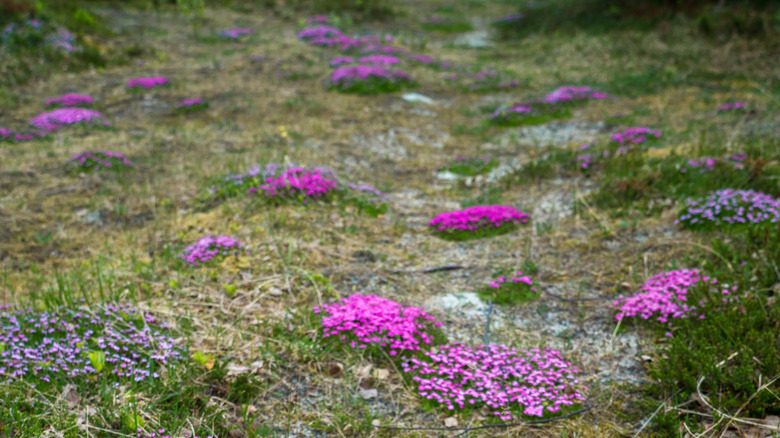The Important Step To Take When Planting Red Creeping Thyme As A Ground Cover
Red creeping thyme (Thymus serpyllum) is gaining popularity both as a perennial bedding plant and as an alternative to turf grass. When you see this lovely low-growing ground cover, it's easy to see why people like it, and if you've grown it yourself, you know how easily it grows and spreads. This can be considered good or bad. For those looking to replace grass with a pollinator-friendly option, red creeping thyme is a viable choice, but you have to consider your neighbors. If your ground cover creeps into their lawn, you may find yourself in a turf (grass) war. The key to keeping red creeping thyme in place is making sure a secure barrier to its spread is in place.
This beautiful ground cover earned its name from its growing habit. Red creeping thyme spreads its roots in all directions, producing more vertical growth, which produces more roots, and so on. It's not called leaping thyme because it does grow fairly slowly, creeping along as it spreads. Red creeping thyme is not difficult to manage, but it does require some forethought to keep it from getting out of control.
Planting red creeping thyme in your yard (and keeping it there)
You can use red creeping thyme as a grass alternative in a few different ways. A stunning way to create a dynamic outdoor space is to leave space for red creeping thyme between pavers. The contrast between green and gray, soft and solid, and structure and nature adds wonderful texture and interest to small spaces.
Those considering red creeping thyme as an alternative to grass for the entire lawn should start by figuring out how to keep this ground cover confined within their own yard. If you have decided to grow red creeping thyme as a lawn alternative, install barriers around your space — if needed. Yards that are completely surrounded by cement, like driveways and sidewalks, will not need barriers since these surfaces will stop the plant from spreading. However, if you only share a fence with your neighbor, plastic or metal landscaping edging between your lawns will stop roots from breaching property lines and help you avoid conflict.
Adding red creeping thyme in a flower bed
In flower beds, ground covers can replace the need for mulch by protecting the soil, reducing evaporation, and suppressing weeds. Planting red creeping thyme as a ground cover in a flower bed offers a perk that mulch does not: Its masses of blooms attract and feed beneficial pollinators like insects and hummingbirds. In most regions, this plant blooms from mid-summer through September, adding months of color to your landscaping.
If you just plant a few patches of red creeping thyme in your flowerbed, it will probably take a few years for it to completely fill in. That timeframe will vary depending on how many plants you start with and how big they are when planted. Once this ground cover fills the bed, you'll have to maintain it. In raised beds or near retaining walls, red creeping thyme spills over beautifully, requiring an occasional trim. Every year or so, you will also need to trim your ground cover back to about 6 to 12 inches away from the base of your perennial plants to keep them from competing for resources.


